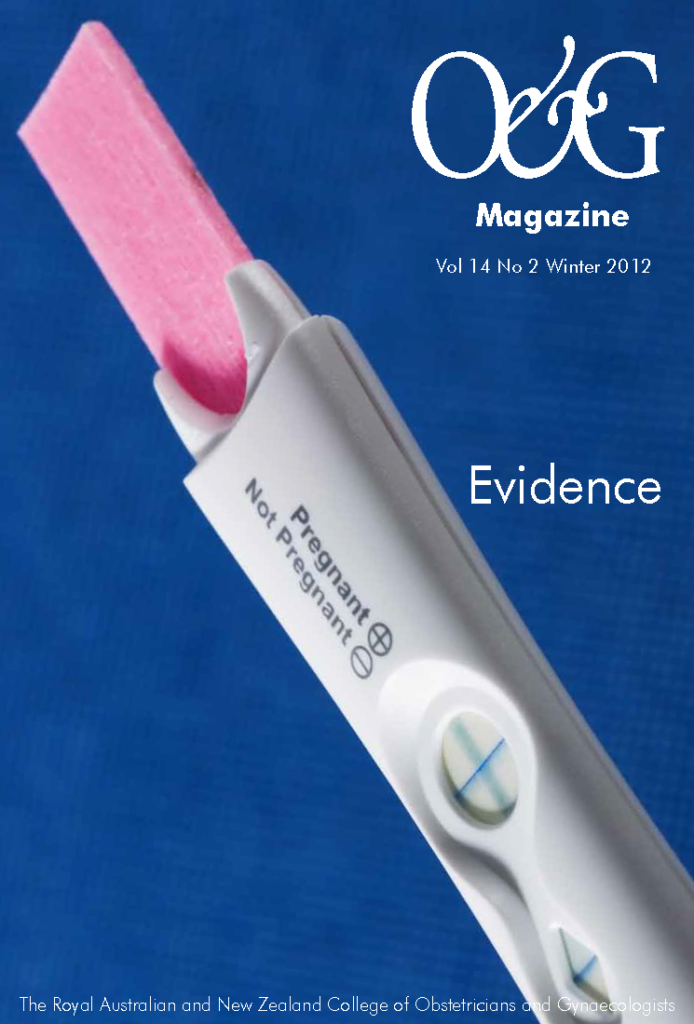Q&a attempts to provide balanced answers to those curly-yet-common questions in obstetrics and gynaecology for the broader O&G Magazine readership including Diplomates, Trainees, medical students and other health professionals.
Q What do you do when faced with unexpected ovarian pathology at laparotomy for benign indication in a premenopausal woman?
a During a career in obstetrics and gynaecology, unexpected pathology is likely to be encountered intra-operatively.1,2 When these findings affect the genital tract, it can be difficult to know how best to proceed – particularly in the young or premenopausal woman who may not have completed, or even commenced, her reproductive life.
Many of us have been in the uncomfortable position of performing surgery for an ectopic, only to find that the contralateral tube is also abnormal; or, in a patient with a compromised tube, that the new problem is unexpectedly on the ‘good’ side. With ovarian pathology at hysterectomy for a benign indication, the issue is less thorny. As pregnancy will no longer be possible, dealing with an unexpected finding appears more straightforward. Guidelines and clinical practice with reference to elective bilateral salpingo-oophorectomy (BSO) at hysterectomy have changed significantly in recent years, but perhaps our attitudes to this small endocrine organ have not moved with the times?
As medical students, we probably all heard countless iterations of ‘the ovary discussion’. ‘They’re going to stop working soon anyhow, so while we’re in there we may as well…’ It was common to routinely remove healthy ovaries at the time of a hysterectomy performed for benign indications (most commonly menorrhagia or dysfunctional uterine bleeding during the climacteric) in relatively young women. The rationale was that over 45 years of age the ovaries were nearing their ‘use by’ date and, left in situ, posed a one in 80 lifetime risk of ovarian cancer.
The American Congress of Obstetricians and Gynecologists recommended a conservative approach to elective BSO at hysterectomy in 20084; our own College followed suit in 2009.5 But it seems a change in practice may be difficult to achieve. Contrary to the College guideline, in 2011, 50 per cent of surveyed O and G specialists and registrars in West Sydney still recommended routine elective oophorectomy at the time of hysterectomy for women aged 55 and over; perhaps because fewer than half of respondents (44 per cent) were aware of the contents of the College statement.6
If we accept that best practice is to leave the ovaries in situ if they are healthy, what are the implications for ovaries that might be diseased? Ms J was a 39-year-old with menorrhagia and uterine fibroids. Medical management and trial of intrauterine system failed to control her symptoms. After consultation with a gynaecologist (who was aware of the College guideline) she opted for a total abdominal hysterectomy with ovarian conservation. Unexpectedly, at laparotomy her right ovary appeared grossly abnormal; enlarged to 8cm in diameter, it had a rubbery consistency. What to do?
Where malignancy is suspected the situation appears relatively straightforward and most gynaecologists probably wouldn’t think twice about removing the ovary, unless the patient specifically desired future fertility. However, even where malignancy is suspected there may be good clinical reasons to delay definitive management. Tumour markers and imaging may confirm the diagnosis; a staging procedure may be the optimal management; or it may be a situation where dissemination of malignant cells is likely if removal is attempted.3 First, do no harm.
Returning to our patient, when the grossly enlarged ovary was noted – ‘I didn’t know what it was, but I knew I had never seen anything like it’ – the surgeon felt that a unilateral salpingo-oophorectomy was the best option. There was no obvious cyst to remove and frozen section was not available without prior arrangement. Histology showed massive ovarian oedema, a rare benign condition ascribed to recurrent partial torsion where lymphatic and venous drainage are impaired, but the arterial supply is preserved, protecting the ovary from necrosis.7
Could we have left the ovary? Surprisingly, even in the case of ovarian torsion with frank necrosis a conservative approach is now recommended, particularly in children and adolescents, as rates of ovarian recovery after torsion with prolonged ischaemia are good.3 Is the balance of risk and benefit different in the perimenopausal woman? In our case, the surgeon and patient had discussed ovarian conservation pre-operatively. The patient was in a same-sex relationship and not planning to have children. She had no family history of ovarian cancer and was happy to ‘keep’ her ovaries based on a discussion about the merits of endogenous hormone production (bone, cardiovascular, libido). She understood and accepted the small lifetime risk of ovarian cancer. However, many of us have encountered patients who are not ambivalent about oophorectomy.
Perhaps the only way to understand the potential importance of a woman’s ovaries to her is to think about men; specifically, the male gonad. Unlike the ovary, homage is regularly paid to the testis in common parlance. Testes are used as a metaphor for courage (‘that took balls’), as disparagement (‘bollocks to that’), and as an expression of disbelief (‘balls!’). So let us imagine a clinical scenario: your husband, brother or son goes into hospital for a relatively simple urological procedure; let’s say a transurethral resection of the prostate (TURP). Intra-operatively one of the surgeons becomes suspicious that the patient’s testicle is pathologically enlarged and feels a bit rubbery. Based on his concern, he removes the testicle without consent. Would we expect the patient to react with equanimity? Are we perhaps underestimating the impact of oophorectomy on our patients due to our historical practice? Our recommendations: read C-Gyn 255, remember that a ‘use by’ and a ‘best before’ date are different9, and the next time you see an ovary, consider leaving it right where it is.
References
- Stedman C, Kline R. Intraoperative complications and unexpected pathology at the time of cesarean section. Obstet Gynecol Clin North Am. 1988;15(4): 745.
- Tsaia CL, Longa CY. Incidental finding of a benign bladder tumor during the tension-free vaginal tape procedure. Gynecol Obstet Invest. 2007; 63: 28–30.
- Hayes-Jordan A. Surgical management of the incidentally identified ovarian mass. Sem Ped Surg. 2005; 14(2): 106-110.
- Elective and risk-reducing salpingo-oophorectomy. ACOG Practice Bulletin No. 89: Obstet Gynecol. 2008; 111(1): 231
- Prophylactic oophorectomy at the time of hysterectomy for benign conditions. RANZCOG C-Gyn 25. O&G Magazine. 2009; 11(3): 75.
- Brand AH. The RANZCOG college statement on prophylactic oophorectomy in older women undergoing hysterectomy for benign disease: is the evidence sufficient to change practice? ANZJOG. 2011; 51(4), 296-300.
- Daboubie, M.K., Khreisat, B. (2008). Massive ovarian oedema: literature review and case presentation. EMHJ. 2008; 14 (4): 972-977.
- Studd J. Ovariotomy for menstrual madness and premenstrual syndrome–19th century history and lessons for current practice. Gynecol Endocrinol. 2006; 22(8): 411-5.
- Bowden J. Best before versus use by. Listener. 2011; 3694: 24.






Leave a Reply